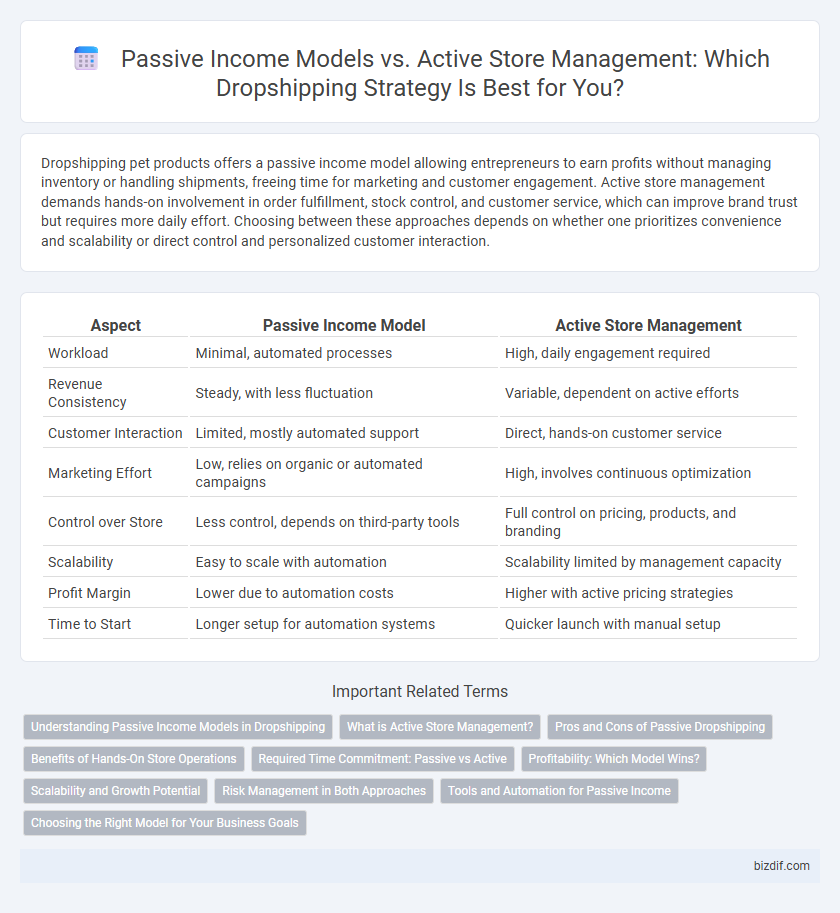Dropshipping pet products offers a passive income model allowing entrepreneurs to earn profits without managing inventory or handling shipments, freeing time for marketing and customer engagement. Active store management demands hands-on involvement in order fulfillment, stock control, and customer service, which can improve brand trust but requires more daily effort. Choosing between these approaches depends on whether one prioritizes convenience and scalability or direct control and personalized customer interaction.
Table of Comparison
| Aspect | Passive Income Model | Active Store Management |
|---|---|---|
| Workload | Minimal, automated processes | High, daily engagement required |
| Revenue Consistency | Steady, with less fluctuation | Variable, dependent on active efforts |
| Customer Interaction | Limited, mostly automated support | Direct, hands-on customer service |
| Marketing Effort | Low, relies on organic or automated campaigns | High, involves continuous optimization |
| Control over Store | Less control, depends on third-party tools | Full control on pricing, products, and branding |
| Scalability | Easy to scale with automation | Scalability limited by management capacity |
| Profit Margin | Lower due to automation costs | Higher with active pricing strategies |
| Time to Start | Longer setup for automation systems | Quicker launch with manual setup |
Understanding Passive Income Models in Dropshipping
Passive income models in dropshipping rely on automated processes such as inventory management, order fulfillment, and customer service, minimizing hands-on involvement. This approach leverages tools like automated supplier integrations and marketing funnels to generate sales with limited daily oversight. Understanding how to set up these systems effectively can create a scalable revenue stream without continuous active management.
What is Active Store Management?
Active store management in dropshipping involves hands-on oversight of daily operations, including inventory updates, customer service, marketing strategies, and order fulfillment. This approach requires continuous monitoring to optimize product listings, handle supplier communications, and respond promptly to customer inquiries. Unlike passive income models, active management demands consistent engagement to drive sales growth and maintain customer satisfaction.
Pros and Cons of Passive Dropshipping
Passive dropshipping offers the advantage of low upfront investment and minimal inventory management, making it accessible for entrepreneurs seeking flexible income streams. However, reliance on suppliers can lead to inconsistent product quality and shipping delays, impacting customer satisfaction. Limited control over branding and customer experience poses challenges for building long-term business value compared to active store management.
Benefits of Hands-On Store Operations
Hands-on store operations in dropshipping enable real-time inventory control and personalized customer service, directly enhancing customer satisfaction and retention. Active management allows for quick adaptation to market trends and competitor actions, optimizing product selection and pricing strategies. This approach maximizes profit potential by closely monitoring store performance and promptly addressing issues, unlike passive income models that rely on automation and lack immediate responsiveness.
Required Time Commitment: Passive vs Active
Passive income in dropshipping requires significantly less time commitment as it primarily involves automating order processing, supplier communication, and marketing through tools like auto-fulfillment software and scheduled social media posts. Active store management demands continuous involvement, including real-time customer service, inventory updates, and hands-on marketing strategies such as dynamic pricing and personalized promotions. Business owners must weigh the time investment between setting up automated systems for passive income and the ongoing operational tasks necessary for active store management success.
Profitability: Which Model Wins?
Passive income models in dropshipping rely on automated processes and minimal day-to-day involvement, often resulting in steady but limited profit margins. Active store management demands continuous effort in marketing, customer service, and inventory optimization, frequently driving higher profitability due to improved customer retention and dynamic pricing strategies. Data from industry reports show active management stores can achieve profit margins up to 30% greater than passive models due to personalized customer engagement and adaptive business practices.
Scalability and Growth Potential
The passive income model in dropshipping offers scalability through automation and outsourced operations, allowing entrepreneurs to grow without constant hands-on management. Active store management demands continuous involvement but enables rapid adaptation to market trends and personalized customer experiences, potentially leading to higher profit margins. Balancing automation with strategic engagement maximizes growth potential by combining operational efficiency with agile business decisions.
Risk Management in Both Approaches
In dropshipping, passive income models minimize upfront investment and inventory risks by automating order fulfillment, but they often face challenges in quality control and supplier reliability. Active store management requires hands-on oversight, enabling quicker response to market trends and customer issues, though it involves higher operational risks and time commitments. Effective risk management in both approaches depends on balancing automation efficiency with proactive monitoring of supplier performance and customer satisfaction.
Tools and Automation for Passive Income
Dropshipping leverages automation tools such as inventory management software, automated order processing, and AI-driven customer service to create a scalable passive income model. Tools like Oberlo, Shopify apps, and Zapier streamline operations by syncing suppliers, orders, and shipments with minimal manual intervention. This automation reduces active store management time, allowing entrepreneurs to generate consistent revenue without daily operational involvement.
Choosing the Right Model for Your Business Goals
Choosing the right dropshipping model hinges on aligning your business goals with operational involvement levels; the passive income model offers automation and scalability with less daily management, ideal for entrepreneurs seeking flexibility. Active store management demands hands-on engagement in marketing, customer service, and inventory oversight, suitable for those aiming for rapid growth and personalized brand experiences. Evaluate your priorities in time commitment, control, and growth trajectory to select a model that maximizes profitability and sustainability.
Passive Income Model vs Active Store Management Infographic

 bizdif.com
bizdif.com